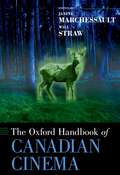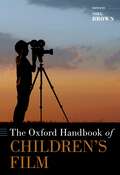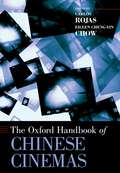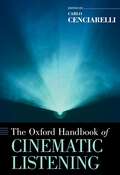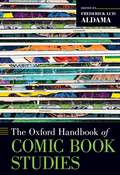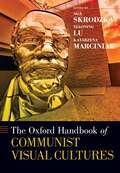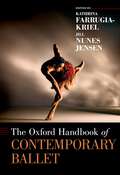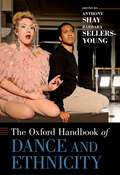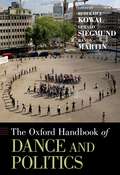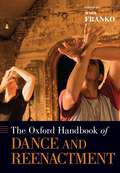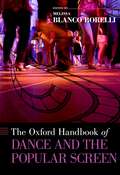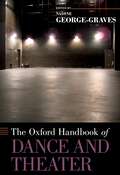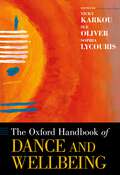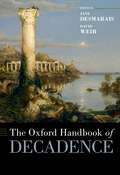- Table View
- List View
The Oxford Handbook of Byzantine Art and Architecture (Oxford Handbooks)
by Ellen C. SchwartzByzantine art has been an underappreciated field, often treated as an adjunct to the arts of the medieval West, if considered at all. In illustrating the richness and diversity of art in the Byzantine world, this handbook will help establish the subject as a distinct field worthy of serious inquiry. Essays consider Byzantine art as art made in the eastern Mediterranean world, including the Balkans, Russia, the Near East and north Africa, between the years 330 and 1453. Much of this art was made for religious purposes, created to enhance and beautify the Orthodox liturgy and worship space, as well as to serve in a royal or domestic context. Discussions in this volume will consider both aspects of this artistic creation, across a wide swath of geography and a long span of time. The volume marries older, object-based considerations of themes and monuments which form the backbone of art history, to considerations drawing on many different methodologies-sociology, semiotics, anthropology, archaeology, reception theory, deconstruction theory, and so on-in an up-to-date synthesis of scholarship on Byzantine art and architecture. The Oxford Handbook of Byzantine Art and Architecture is a comprehensive overview of a particularly rich field of study, offering a window into the world of this fascinating and beautiful period of art.
The Oxford Handbook of Canadian Cinema (Oxford Handbooks)
by Will Straw Janine MarchessaultThe chapters in The Oxford Handbook of Canadian Cinema present a rich, diverse overview of Canadian cinema. Responding to the latest developments in Canadian film studies, this volume takes into account the variety of artistic voices, media technologies, and places which have marked cinema in Canada throughout its history. Drawing on a range of established and emerging scholars from a range of disciplines, this volume will be useful to teachers, scholars, and to a general readership interested in cinema in Canada. Moving beyond the director-focused approach of much previous scholarship, this book is concerned with communities, institutions, and audiences for Canadian cinema at both national and international levels. The choice of subjects covered ranges from popular, genre cinema to the most experimental of artistic interventions. Canadian cinema is seen in its interaction with other forms of art-making and media production in Canada and at the international level. Particular attention has been paid to the work of Indigenous filmmakers, members of diasporic communities and feminist and LGBTQ artists. The result is a book attentive to the complex social and institutional contexts in which Canadian cinema is made and consumed.
The Oxford Handbook of Canadian Cinema (Oxford Handbooks)
The chapters in The Oxford Handbook of Canadian Cinema present a rich, diverse overview of Canadian cinema. Responding to the latest developments in Canadian film studies, this volume takes into account the variety of artistic voices, media technologies, and places which have marked cinema in Canada throughout its history. Drawing on a range of established and emerging scholars from a range of disciplines, this volume will be useful to teachers, scholars, and to a general readership interested in cinema in Canada. Moving beyond the director-focused approach of much previous scholarship, this book is concerned with communities, institutions, and audiences for Canadian cinema at both national and international levels. The choice of subjects covered ranges from popular, genre cinema to the most experimental of artistic interventions. Canadian cinema is seen in its interaction with other forms of art-making and media production in Canada and at the international level. Particular attention has been paid to the work of Indigenous filmmakers, members of diasporic communities and feminist and LGBTQ artists. The result is a book attentive to the complex social and institutional contexts in which Canadian cinema is made and consumed.
The Oxford Handbook of Children's Film (Oxford Handbooks)
by Noel BrownThe Oxford Handbook of Children's Film is the most comprehensive study of international children's cinema published to date. Overturning common prejudices that films for children are unworthy of serious attention, it presents nuanced and wide-ranging discussions from senior and junior scholars alike of iconic and neglected productions from Hollywood, Britain, France, Germany, Sweden, Norway, Hungary, Australia, China, Japan, South Korea, India, Iran, Kenya, and several other countries. Featuring contributions by leading scholars in the field, the volume considers a range of issues central to the study of children's film, including questions of form and definition; representations of childhood and growing up; music, stardom, and performance; how children's films reflect national identity or serve as vehicles of state ideology and propaganda; the phenomenon of Hollywood 'family entertainment', especially the role of the Disney company; and how children and young people (as well as older audiences) engage with children's film culture. As a whole, the volume makes a substantial contribution to the emerging field of children's film studies, and will be of great interest to scholars of children's media and culture more broadly.
The Oxford Handbook of Children's Film (Oxford Handbooks)
The Oxford Handbook of Children's Film is the most comprehensive study of international children's cinema published to date. Overturning common prejudices that films for children are unworthy of serious attention, it presents nuanced and wide-ranging discussions from senior and junior scholars alike of iconic and neglected productions from Hollywood, Britain, France, Germany, Sweden, Norway, Hungary, Australia, China, Japan, South Korea, India, Iran, Kenya, and several other countries. Featuring contributions by leading scholars in the field, the volume considers a range of issues central to the study of children's film, including questions of form and definition; representations of childhood and growing up; music, stardom, and performance; how children's films reflect national identity or serve as vehicles of state ideology and propaganda; the phenomenon of Hollywood 'family entertainment', especially the role of the Disney company; and how children and young people (as well as older audiences) engage with children's film culture. As a whole, the volume makes a substantial contribution to the emerging field of children's film studies, and will be of great interest to scholars of children's media and culture more broadly.
The Oxford Handbook of Chinese Cinemas (Oxford Handbooks)
What does it mean for a cinematic work to be "Chinese"? Does it refer specifically to a work's subject, or does it also reflect considerations of language, ethnicity, nationality, ideology, or political orientation? Such questions make any single approach to a vast field like "Chinese cinema" difficult at best. Accordingly, The Oxford Handbook of Chinese Cinemas situates the term more broadly among various different phases, genres, and distinct national configurations, while taking care to address the consequences of grouping together so many disparate histories under a single banner. Offering both a platform for cross-disciplinary dialogue and a mapping of Chinese cinema as an expanded field, this Handbook presents thirty-three essays by leading researchers and scholars intent on yielding new insights and new analyses using three different methodologies. Chapters in Part I investigate the historical periodizations of the field through changing notions of national and political identity -- all the way from the industry's beginnings in the 1920s up to its current forms in contemporary Hong Kong, Taiwan, and the global diaspora. Chapters in Part II feature studies centered on the field's taxonomical formalities, including such topics as the role of the Chinese opera in technological innovation, the political logic of the "Maoist film," and the psychoanalytic formula of the kung fu action film. Finally, in Part III, focus is given to the structural elements that comprise a work's production, distribution, and reception to reveal the broader cinematic apparatuses within which these works are positioned. Taken together, the multipronged approach supports a wider platform beyond the geopolitical and linguistic limitations in existing scholarship. Expertly edited to illustrate a representative set of up to date topics and approaches, The Oxford Handbook of Chinese Cinemas provides a vital addition to a burgeoning field still in its formative stages.
The Oxford Handbook of Cinematic Listening (Oxford Handbooks)
by Carlo CenciarelliThe Oxford Handbook of Cinematic Listening explores the place of cinema in the history of listening. It looks at the ways in which listening to film is situated in textual, spatial, and social practices, and also studies how cinematic modes of listening have extended into other media and everyday experiences. Chapters are structured around six themes. Part I ("Genealogies and Beginnings") considers film sound in light of pre-existing practices such as opera and shadow theatre, and also explores changes in listening taking place at critical junctures in the early history of cinema. Part II ("Locations and Relocations") focuses on specific venues and presentational practices from roadshow movies to contemporary live-score screenings. Part III ("Representations and Re-Presentations") zooms into the formal properties of specific films, analyzing representations of listening on screen as well as the role of sound as a representational surplus. Part IV ("The Listening Body") focuses on the power of cinematic sound to engage the full body sensorium. Part V ("Listening Again") discusses a range of ways in which film sound is encountered and reinterpreted outside the cinema, whether through ancillary materials such as songs and soundtrack albums, or in experimental conditions and pedagogical contexts. Part VI ("Across Media") compares cinema with the listening protocols of TV series and music video, promenade theatre and personal stereos, video games and Virtual Reality.
The Oxford Handbook of Cinematic Listening (Oxford Handbooks)
The Oxford Handbook of Cinematic Listening explores the place of cinema in the history of listening. It looks at the ways in which listening to film is situated in textual, spatial, and social practices, and also studies how cinematic modes of listening have extended into other media and everyday experiences. Chapters are structured around six themes. Part I ("Genealogies and Beginnings") considers film sound in light of pre-existing practices such as opera and shadow theatre, and also explores changes in listening taking place at critical junctures in the early history of cinema. Part II ("Locations and Relocations") focuses on specific venues and presentational practices from roadshow movies to contemporary live-score screenings. Part III ("Representations and Re-Presentations") zooms into the formal properties of specific films, analyzing representations of listening on screen as well as the role of sound as a representational surplus. Part IV ("The Listening Body") focuses on the power of cinematic sound to engage the full body sensorium. Part V ("Listening Again") discusses a range of ways in which film sound is encountered and reinterpreted outside the cinema, whether through ancillary materials such as songs and soundtrack albums, or in experimental conditions and pedagogical contexts. Part VI ("Across Media") compares cinema with the listening protocols of TV series and music video, promenade theatre and personal stereos, video games and Virtual Reality.
The Oxford Handbook of Comic Book Studies (Oxford Handbooks)
by Frederick Luis AldamaComic book studies has developed as a solid academic discipline, becoming an increasingly vibrant field in the United States and globally. A growing number of dissertations, monographs, and edited books publish every year on the subject, while world comics represent the fastest-growing sector of publishing. The Oxford Handbook of Comic Book Studies looks at the field systematically, examining the history and evolution of the genre from a global perspective. This includes a discussion of how comic books are built out of shared aesthetic systems such as literature, painting, drawing, photography, and film. The Handbook brings together readable, jargon-free essays written by established and emerging scholars from diverse geographic, institutional, gender, and national backgrounds. In particular, it explores how the term "global comics" has been defined, as well the major movements and trends that will drive the field in the years to come. Each essay will help readers understand comic books as a storytelling form grown within specific communities, and will also show how these forms exist within what can be considered a world system of comics.
The Oxford Handbook of Comic Book Studies (Oxford Handbooks)
Comic book studies has developed as a solid academic discipline, becoming an increasingly vibrant field in the United States and globally. A growing number of dissertations, monographs, and edited books publish every year on the subject, while world comics represent the fastest-growing sector of publishing. The Oxford Handbook of Comic Book Studies looks at the field systematically, examining the history and evolution of the genre from a global perspective. This includes a discussion of how comic books are built out of shared aesthetic systems such as literature, painting, drawing, photography, and film. The Handbook brings together readable, jargon-free essays written by established and emerging scholars from diverse geographic, institutional, gender, and national backgrounds. In particular, it explores how the term "global comics" has been defined, as well the major movements and trends that will drive the field in the years to come. Each essay will help readers understand comic books as a storytelling form grown within specific communities, and will also show how these forms exist within what can be considered a world system of comics.
The Oxford Handbook of Communist Visual Cultures (Oxford Handbooks)
by Aga Skrodzka Katarzyna Marciniak Xiaoning LuStereotypes often cast communism as a defunct, bankrupt ideology and a relic of the distant past. However, recent political movements like Europe's anti-austerity protests, the Arab Spring, and Occupy Wall Street suggest that communism is still very much relevant and may even hold the key to a new, idealized future. In The Oxford Handbook of Communist Visual Cultures, contributors trace the legacies of communist ideology in visual culture, from buildings and monuments, murals and sculpture, to recycling campaigns and wall newspapers, all of which work to make communism's ideas and values material. Contributors work to resist the widespread demonization of communism, demystifying its ideals and suggesting that it has visually shaped the modern world in undeniable and complex ways. Together, contributors answer curcial questions like: What can be salvaged and reused from past communist experiments? How has communism impacted the cultures of late capitalism? And how have histories of communism left behind visual traces of potential utopias? An interdisciplinary look at the cultural currency of communism today, The Oxford Handbook of Communist Visual Cultures demonstrates the value of revisiting the practices of the past to form a better vision of the future.
The Oxford Handbook of Communist Visual Cultures (Oxford Handbooks)
Stereotypes often cast communism as a defunct, bankrupt ideology and a relic of the distant past. However, recent political movements like Europe's anti-austerity protests, the Arab Spring, and Occupy Wall Street suggest that communism is still very much relevant and may even hold the key to a new, idealized future. In The Oxford Handbook of Communist Visual Cultures, contributors trace the legacies of communist ideology in visual culture, from buildings and monuments, murals and sculpture, to recycling campaigns and wall newspapers, all of which work to make communism's ideas and values material. Contributors work to resist the widespread demonization of communism, demystifying its ideals and suggesting that it has visually shaped the modern world in undeniable and complex ways. Together, contributors answer curcial questions like: What can be salvaged and reused from past communist experiments? How has communism impacted the cultures of late capitalism? And how have histories of communism left behind visual traces of potential utopias? An interdisciplinary look at the cultural currency of communism today, The Oxford Handbook of Communist Visual Cultures demonstrates the value of revisiting the practices of the past to form a better vision of the future.
The Oxford Handbook of Contemporary Ballet (Oxford Handbooks)
by Kathrina Farrugia-Kriel Jill Nunes JensenIn distinction to many extant histories of ballet, The Oxford Handbook of Contemporary Ballet prioritizes connections between ballet communities as it interweaves chapters by scholars, critics, choreographers, and working professional dancers. The book looks at the many ways ballet functions as a global practice in the 21st century, providing new perspectives on ballet's past, present, and future. As an effort to dismantle the linearity of academic canons, the fifty-three chapters within provide multiple entry points for readers to engage in balletic discourse. With an emphasis on composition and process alongside dances created, and the assertion that contemporary ballet is a definitive era, the book carves out space for critical inquiry. Many of the chapters consider whether or not ballet can reconcile its past and actually become present, while others see ballet as flexible and willing to be remolded at the hands of those with tools to do so.
The Oxford Handbook of Contemporary Ballet (Oxford Handbooks)
In distinction to many extant histories of ballet, The Oxford Handbook of Contemporary Ballet prioritizes connections between ballet communities as it interweaves chapters by scholars, critics, choreographers, and working professional dancers. The book looks at the many ways ballet functions as a global practice in the 21st century, providing new perspectives on ballet's past, present, and future. As an effort to dismantle the linearity of academic canons, the fifty-three chapters within provide multiple entry points for readers to engage in balletic discourse. With an emphasis on composition and process alongside dances created, and the assertion that contemporary ballet is a definitive era, the book carves out space for critical inquiry. Many of the chapters consider whether or not ballet can reconcile its past and actually become present, while others see ballet as flexible and willing to be remolded at the hands of those with tools to do so.
The Oxford Handbook of Dance and Ethnicity (Oxford Handbooks)
by Anthony Shay and Barbara Sellers-YoungDance intersects with ethnicity in a powerful variety of ways and at a broad set of venues. Dance practices and attitudes about ethnicity have sometimes been the source of outright discord, as when African Americans were - and sometimes still are - told that their bodies are 'not right' for ballet, when Anglo Americans painted their faces black to perform in minstrel shows, when 19th century Christian missionaries banned the performance of particular native dance traditions throughout much of Polynesia, and when the Spanish conquistadors and church officials banned sacred Aztec dance rituals. More recently, dance performances became a locus of ethnic disunity in the former Yugoslavia as the Serbs of Bosnia attended dance concerts but only applauded for the Serbian dances, presaging the violent disintegration of that failed state. The Oxford Handbook of Dance and Ethnicity brings together scholars from across the globe in an investigation of what it means to define oneself in an ethnic category and how this category is performed and represented by dance as an ethnicity. Newly-commissioned for the volume, the chapters of the book place a reflective lens on dance and its context to examine the role of dance as performed embodiment of the historical moments and associated lived identities. In bringing modern dance and ballet into the conversation alongside forms more often considered ethnic, the chapters ask the reader to contemplate previous categories of folk, ethnic, classical, and modern. From this standpoint, the book considers how dance maintains, challenges, resists or in some cases evolves new forms of identity based on prior categories. Ultimately, the goal of the book is to acknowledge the depth of research that has been undertaken and to promote continued research and conceptualization of dance and its role in the creation of ethnicity. Dance and ethnicity is an increasingly active area of scholarly inquiry in dance studies and ethnomusicology alike and the need is great for serious scholarship to shape the contours of these debates. The Oxford Handbook of Dance and Ethnicity provides an authoritative and up-to-date survey of original research from leading experts which will set the tone for future scholarly conversation.
The Oxford Handbook of Dance and Politics (Oxford Handbooks)
by Rebekah J. Kowal, Gerald Siegmund and Randy MartinIn recent decades, dance has become a vehicle for querying assumptions about what it means to be embodied, in turn illuminating intersections among the political, the social, the aesthetical, and the phenomenological. The Oxford Handbook of Dance and Politics edited by internationally lauded scholars Rebekah Kowal, Gerald Siegmund, and the late Randy Martin presents a compendium of newly-commissioned chapters that address the interdisciplinary and global scope of dance theory - its political philosophy, social movements, and approaches to bodily difference such as disability, postcolonial, and critical race and queer studies. In six sections 30 of the most prestigious dance scholars in the US and Europe track the political economy of dance and analyze the political dimensions of choreography, of writing history, and of embodied phenomena in general. Employing years of intimate knowledge of dance and its cultural phenomenology, scholars urge readers to re-think dominant cultural codes, their usages, and the meaning they produce and theorize ways dance may help to re-signify and to re-negotiate established cultural practices and their inherent power relations. This handbook poses ever-present questions about dance politics-which aspects or effects of a dance can be considered political? What possibilities and understandings of politics are disclosed through dance? How does a particular dance articulate or undermine forces of authority? How might dance relate to emancipation or bondage of the body? Where and how can dance articulate social movements, represent or challenge political institutions, or offer insight into habits of labor and leisure? The handbook opens its critical terms in two directions. First, it offers an elaborated understanding of how dance achieves its politics. Second, it illustrates how notions of the political are themselves expanded when viewed from the perspective of dance, thus addressing both the relationship between the politics in dance and the politics of dance. Using the most sophisticated theoretical frameworks and engaging with the problematics that come from philosophy, social science, history, and the humanities, chapters explore the affinities, affiliations, concepts, and critiques that are inherent in the act of dance, and questions about matters political that dance makes legible.
The Oxford Handbook of Dance and Politics (Oxford Handbooks)
In recent decades, dance has become a vehicle for querying assumptions about what it means to be embodied, in turn illuminating intersections among the political, the social, the aesthetical, and the phenomenological. The Oxford Handbook of Dance and Politics edited by internationally lauded scholars Rebekah Kowal, Gerald Siegmund, and the late Randy Martin presents a compendium of newly-commissioned chapters that address the interdisciplinary and global scope of dance theory - its political philosophy, social movements, and approaches to bodily difference such as disability, postcolonial, and critical race and queer studies. In six sections 30 of the most prestigious dance scholars in the US and Europe track the political economy of dance and analyze the political dimensions of choreography, of writing history, and of embodied phenomena in general. Employing years of intimate knowledge of dance and its cultural phenomenology, scholars urge readers to re-think dominant cultural codes, their usages, and the meaning they produce and theorize ways dance may help to re-signify and to re-negotiate established cultural practices and their inherent power relations. This handbook poses ever-present questions about dance politics-which aspects or effects of a dance can be considered political? What possibilities and understandings of politics are disclosed through dance? How does a particular dance articulate or undermine forces of authority? How might dance relate to emancipation or bondage of the body? Where and how can dance articulate social movements, represent or challenge political institutions, or offer insight into habits of labor and leisure? The handbook opens its critical terms in two directions. First, it offers an elaborated understanding of how dance achieves its politics. Second, it illustrates how notions of the political are themselves expanded when viewed from the perspective of dance, thus addressing both the relationship between the politics in dance and the politics of dance. Using the most sophisticated theoretical frameworks and engaging with the problematics that come from philosophy, social science, history, and the humanities, chapters explore the affinities, affiliations, concepts, and critiques that are inherent in the act of dance, and questions about matters political that dance makes legible.
The Oxford Handbook of Dance and Reenactment (Oxford Handbooks)
by Mark FrankoThe Oxford Handbook of Dance and Reenactment brings together a cross-section of artists and scholars engaged with the phenomenon of reenactment in dance from a practical and theoretical standpoint. Synthesizing myriad views on danced reenactment and the manner in which this branch of choreographic performance intersects with important cultural concerns around appropriation this Handbook addresses originality, plagiarism, historicity, and spatiality as it relates to cultural geography. Others topics treated include transmission as a heuristic device, the notion of the archive as it relates to dance and as it is frequently contrasted with embodied cultural memory, pedagogy, theory of history, reconstruction as a methodology, testimony and witnessing, theories of history as narrative and the impact of dance on modernist literature, and relations of reenactment to historical knowledge and new media.
The Oxford Handbook of Dance and Reenactment (Oxford Handbooks)
The Oxford Handbook of Dance and Reenactment brings together a cross-section of artists and scholars engaged with the phenomenon of reenactment in dance from a practical and theoretical standpoint. Synthesizing myriad views on danced reenactment and the manner in which this branch of choreographic performance intersects with important cultural concerns around appropriation this Handbook addresses originality, plagiarism, historicity, and spatiality as it relates to cultural geography. Others topics treated include transmission as a heuristic device, the notion of the archive as it relates to dance and as it is frequently contrasted with embodied cultural memory, pedagogy, theory of history, reconstruction as a methodology, testimony and witnessing, theories of history as narrative and the impact of dance on modernist literature, and relations of reenactment to historical knowledge and new media.
The Oxford Handbook of Dance and the Popular Screen (Oxford Handbooks)
by Melissa Blanco BorelliThe Oxford Handbook of Dance and the Popular Screen sets the agenda for the study of dance in popular moving images - films, television shows, commercials, music videos, and YouTube - and offers new ways to understand the multi-layered meanings of the dancing body by engaging with methodologies from critical dance studies, performance studies, and film/media analysis. Through thorough engagement with these approaches, the chapters demonstrate how dance on the popular screen might be read and considered through bodies and choreographies in moving media. Questions the contributors consider include: How do dance and choreography function within the filmic apparatus? What types of bodies are associated with specific dances and how does this affect how dance(s) is/are perceived in the everyday? How do the dancing bodies on screen negotiate power, access, and agency? How are multiple choreographies of identity (e.g., race, class, gender, sexuality, and nation) set in motion through the narrative, dancing bodies, and/or dance style? What types of corporeal labors (dance training, choreographic skill, rehearsal, the constructed notion of "natural talent") are represented or ignored? What role does a specific film have in the genealogy of Hollywood dance film? How does the Hollywood dance film inform how dance operates in making cultural meanings? Whether looking at Bill "Bojangles" Robinson's tap steps in Stormy Weather, or Baby's leap into Johnny Castle's arms in Dirty Dancing, or even Neo's backwards bend in The Matrix, the book's arguments offer powerful new scholarship on dance in the popular screen.
The Oxford Handbook of Dance and Theater (Oxford Handbooks)
The Oxford Handbook of Dance and Theater collects a critical mass of border-crossing scholarship on the intersections of dance and theatre. Taking corporeality as an idea that unites the work of dance and theater scholars and artists, and embodiment as a negotiation of power dynamics with important stakes, these essays focus on the politics and poetics of the moving body in performance both on and off stage. Contemporary stage performances have sparked global interest in new experiments between dance and theater, and this volume situates this interest in its historical context by extensively investigating other such moments: from pagan mimes of late antiquity to early modern archives to Bolshevik Russia to post-Sandinista Nicaragua to Chinese opera on the international stage, to contemporary flash mobs and television dance contests. Ideologically, the essays investigate critical race theory, affect theory, cognitive science, historiography, dance dramaturgy, spatiality, gender, somatics, ritual, and biopolitics among other modes of inquiry. In terms of aesthetics, they examine many genres such as musical theater, contemporary dance, improvisation, experimental theater, television, African total theater, modern dance, new Indian dance theater aesthetics, philanthroproductions, Butoh, carnival, equestrian performance, tanztheater, Korean Talchum, Nazi Movement Choirs, Lindy Hop, Bomba, Caroline Masques, political demonstrations, and Hip Hop. The volume includes innovative essays from both young and seasoned scholars and scholar/practitioners who are working at the cutting edges of their fields. The handbook brings together essays that offer new insight into well-studied areas, challenge current knowledge, attend to neglected practices or moments in time, and that identify emergent themes. The overall result is a better understanding of the roles of dance and theater in the performative production of meaning.
The Oxford Handbook of Dance and Wellbeing (Oxford Handbooks)
by Vicky Karkou, Sue Oliver and Sophia LycourisIn recent years, a growth in dance and wellbeing scholarship has resulted in new ways of thinking that place the body, movement, and dance in a central place with renewed significance for wellbeing. The Oxford Handbook of Dance and Wellbeing examines dance and related movement practices from the perspectives of neuroscience and health, community and education, and psychology and sociology to contribute towards an understanding of wellbeing, offer new insights into existing practices, and create a space where sufficient exchange is enabled. The handbook's research components include quantitative, qualitative, and arts-based research, covering diverse discourses, methodologies, and perspectives that add to the development of a complete picture of the topic. Throughout the handbook's wide-ranging chapters, the objective observations, felt experiences, and artistic explorations of practitioners interact with and are printed alongside academic chapters to establish an egalitarian and impactful exchange of ideas.
The Oxford Handbook of Dance and Wellbeing (Oxford Handbooks)
In recent years, a growth in dance and wellbeing scholarship has resulted in new ways of thinking that place the body, movement, and dance in a central place with renewed significance for wellbeing. The Oxford Handbook of Dance and Wellbeing examines dance and related movement practices from the perspectives of neuroscience and health, community and education, and psychology and sociology to contribute towards an understanding of wellbeing, offer new insights into existing practices, and create a space where sufficient exchange is enabled. The handbook's research components include quantitative, qualitative, and arts-based research, covering diverse discourses, methodologies, and perspectives that add to the development of a complete picture of the topic. Throughout the handbook's wide-ranging chapters, the objective observations, felt experiences, and artistic explorations of practitioners interact with and are printed alongside academic chapters to establish an egalitarian and impactful exchange of ideas.
The Oxford Handbook of Decadence (Oxford Handbooks)
by Jane Desmarais and David WeirThe meaning of decadence varies with context, depending on what (or who) is understood to have declined, decayed, or degenerated. These negative meanings are familiar from history (the decline and fall of Rome), sociology (the decay of communities), morality (the degeneration of values), and more, including such popular conceptions of decadence as excess and corruption. At the same time, all of this negative decadence has found positive cultural expression, principally in literature, through the work of such celebrated nineteenth-century decadents as Charles Baudelaire, Oscar Wilde, and many others. This volume takes the study of decadence beyond these canonical literary works to explore the phenomenon in broader historical, geographical, and cultural contexts. In thirty-five chapters by esteemed scholars from a range of disciplines, the Oxford Handbook of Decadence addresses different critical periods, such as classical antiquity, various ages of empire, the interwar era in the twentieth century, and contemporary times, as well as key places--France, Belgium, Britain, Italy, Germany, the Nordic nations, Russia and Ukraine, the Ottoman Empire, and Japan--and such genres as the novel, the short story, drama, the essay, prose poetry, and film. The volume also considers decadence more broadly as a culture not limited to literature by tracing its manifestations in such material forms as book design, fashion, interior decoration, and architecture, as well as through the experiential register of the senses: decadent vision, sound, smell, taste, and touch are all reflected, respectively, in painting, music, perfume, cuisine, and feeling. Finally, the chapters explore the theoretical resonance of decadence in such fields as theology, science, ecology, politics, psychoanalysis, and philosophy. By illuminating the various ways decadence can be construed, the Handbook offers an in-depth and original exploration into the paradox of decadence: a culture that draws its creative energy from the idea of decline.
The Oxford Handbook of Decadence (Oxford Handbooks)
The meaning of decadence varies with context, depending on what (or who) is understood to have declined, decayed, or degenerated. These negative meanings are familiar from history (the decline and fall of Rome), sociology (the decay of communities), morality (the degeneration of values), and more, including such popular conceptions of decadence as excess and corruption. At the same time, all of this negative decadence has found positive cultural expression, principally in literature, through the work of such celebrated nineteenth-century decadents as Charles Baudelaire, Oscar Wilde, and many others. This volume takes the study of decadence beyond these canonical literary works to explore the phenomenon in broader historical, geographical, and cultural contexts. In thirty-five chapters by esteemed scholars from a range of disciplines, the Oxford Handbook of Decadence addresses different critical periods, such as classical antiquity, various ages of empire, the interwar era in the twentieth century, and contemporary times, as well as key places--France, Belgium, Britain, Italy, Germany, the Nordic nations, Russia and Ukraine, the Ottoman Empire, and Japan--and such genres as the novel, the short story, drama, the essay, prose poetry, and film. The volume also considers decadence more broadly as a culture not limited to literature by tracing its manifestations in such material forms as book design, fashion, interior decoration, and architecture, as well as through the experiential register of the senses: decadent vision, sound, smell, taste, and touch are all reflected, respectively, in painting, music, perfume, cuisine, and feeling. Finally, the chapters explore the theoretical resonance of decadence in such fields as theology, science, ecology, politics, psychoanalysis, and philosophy. By illuminating the various ways decadence can be construed, the Handbook offers an in-depth and original exploration into the paradox of decadence: a culture that draws its creative energy from the idea of decline.

